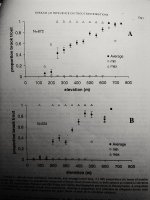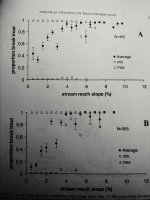k-bob
Well-known member
- Joined
- Jul 29, 2009
- Messages
- 2,371
Charts from Kocosvky/Carline paper ("Stream pH as an Abiotic...," 2005, no free version I see), on proportion of ST v BT in PA streams under various gradient, elevation, and pH conditions. Hundreds of PA streams in data ("N=XXX" on charts).
Interestingly, higher ST proportion at higher elevation (first chart, A = app plateau; B = ridge n valley). Due to lower headwater pH, low buffering bedrock up high, and/or ST feeding more in cold water?...
Also, much more ST than BT at high stream gradient (ST better swimmers or spawners in fast water?). Few BT once a stream is a 7-8% steep one:
Interestingly, higher ST proportion at higher elevation (first chart, A = app plateau; B = ridge n valley). Due to lower headwater pH, low buffering bedrock up high, and/or ST feeding more in cold water?...
Also, much more ST than BT at high stream gradient (ST better swimmers or spawners in fast water?). Few BT once a stream is a 7-8% steep one:





